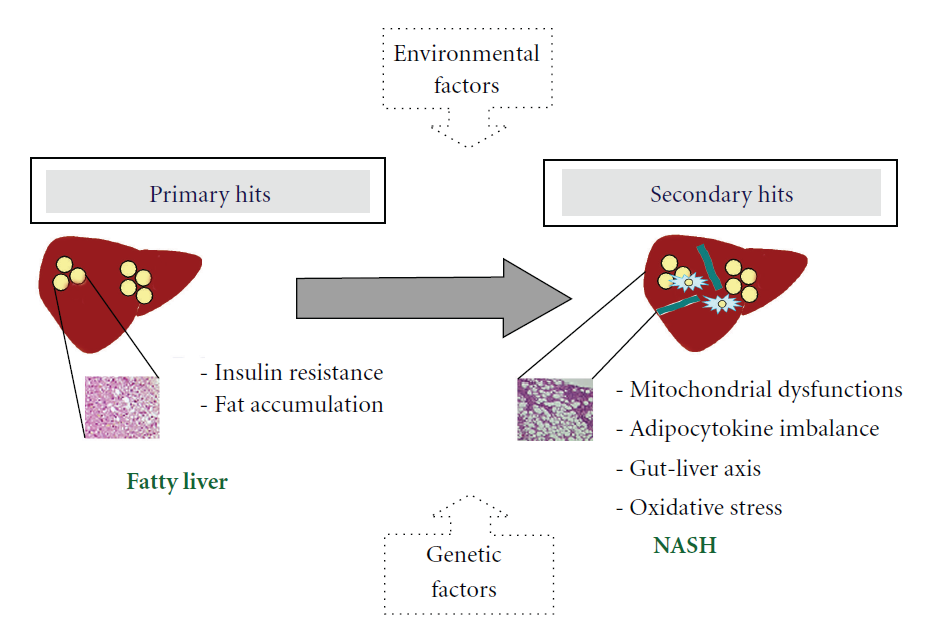NASH Mouse Model Development Service
Animal models can provide critical guidance for understanding specific stages of nonalcoholic steatohepatitis (NASH) pathogenesis and progression, and it is necessary to develop more accurate models to better simulate disease profiles in order to provide increased mechanism understanding and identifying/testing new treatments. Creative Biolabs has developed a series of rat and mouse models for NASH research.
Background
NASH is diagnosed with hepatic and hepatocyte balloon dilatation with or without fibrosis and/or cirrhosis when hepatic steatosis occurs. Animal models are important in elucidating the mechanisms and pathways involved in the pathogenesis of the NASH spectrum, and studies using the rat and mouse models can provide promising results for future NASH treatments. Given the complexity of human behavior and biology, the study of steatohepatitis should not be limited to the liver alone. Appetite regulation, physical activity, food selection, humoral determinants of genetics and body composition, metabolic regulation and extrahepatic tissue inflammation may each play a role in the pathogenesis of NASH.
 Fig.1 Simplified representation of NASH pathogenesis. (Alisi, 2011)
Fig.1 Simplified representation of NASH pathogenesis. (Alisi, 2011)
Animal Models of NASH
It is essential to establish a satisfactory genetically engineered or diet-induced mouse model that completely replicates the key physiological, metabolic, histological, transcriptomic, and cellular signal changes in human progressive NASH for better understanding the pathophysiological mechanisms and therapeutic strategies of NASH. Animal models of NASH can be broadly classified into dietary induction, genetics, or a combination of multiple interventions. To date, no single animal model can cover the full spectrum of human disease progression, but they can mimic the main characteristics of disease.
Below is the list of our mouse models, including but not limited to:
| Murine Models to Study NASH | Description of Impact on NASH Development |
| Methionine and choline deficiency (MCD) dietary model |
Feeding mice with a lipogenic MCD (methionine and choline deficiency) diet is a frequently used and reproducible nutritional model of NASH. The diet usually consists of high-fat and sucrose, deficient in methionine and choline. Depriving animals of choline alone impairs hepatic very-low-density lipoprotein (VLDL) secretion and results in hepatosteatosis, oxidative stress, liver cell death, and changes in cytokines and adipocytokines, but only causes slight hepatic inflammation and fibrosis. MCD model is appropriate for studying histologically advanced NASH and the mechanisms of inflammation and fibrosis in NASH. |
| Choline-deficient, L-amino acid-defined supplemented, high-fat (CDAA) dietary model | Like the MCD diet, animals do not gain weight or exhibit insulin resistance, but can develop into fibrosis. |
| High-cholesterol (HCD) dietary model | Mice with high cholesterol diet reduce VLDL synthesis and β-oxidation of fatty acids and increase apoptosis and hepatic oxidative stress. |
| High sucrose and fructose dietary model | C57BL/6 mice fed with a high-fat, high-fructose diet induce typical hepatic steatosis. |
| Containing trans-fatty acid dietary model | Similar to humans, elevated intake of trans fatty acids promotes metabolic changes in mice, including proatherogenic plasma lipid profiles, hepatomegaly due to fat accumulation and inflammatory NASH-like lesions, and impaired glucose tolerance. |
| ob/ob mice | Leptin-deficient mice. The mice develop into severe insulin resistance and steatosis but are resistant to fibrosis without a second insult. |
| db/db mice | Leptin receptor-deficient mice. Severe glucose intolerance, obesity, and hepatic steatosis; susceptible to fibrosis with a second insult. |
| foz/foz mice | Truncating mutation in Alstrom syndrome I (ALMS1) gene. foz/foz mice are morbidly obese and hyperphagic, and they show insulin resistance, significantly reduced adiponectin levels, increased cholesterol levels, and steatosis with hypoadiponectinemia. |
| SREBP-1c transgenic mice | These mice express a truncated, constitutively active form of the SREBP-1c transcription factor. Severe insulin resistance and spontaneous steatohepatitis with oxidant stress as well as some perivenular fibrosis. |
| MUP-uPA transgenic mice | Hepatocyte-specific overexpression of urokinase plasminogen activator transgenic mice. Severe ER stress, hepatic steatosis, mild fibrosis and hepatocellular carcinoma on a high-fat diet, with TNF-α-driven inflammation. |
| Phosphatase and tensin homolog (PTEN) knockout mice | Hepatocyte-specific PTEN-deficient mice spontaneously develop into hepatomegaly, steatosis, steatohepatitis, hepatocellular carcinoma and triglyceride accumulation with lipogenic gene induction by 40 weeks of age. |
| Methionine adenosyl transferase 1A (Mat 1A) knockout mice | MAT 1A-deficiency mice result in the development of steatosis, NASH, and hepatocellular carcinoma. |
| LDLR knockout mice | LDL receptor global knockout mice. Marked steatosis on a diabetogenic diet for 24 weeks, made worse with the addition of dietary cholesterol, and association with inflammation, oxidant stress, increased fatty acid production and mild fibrosis. |
| Combination models | Genetically modified mouse models fed with NASH inducible diet have progressive NASH similar to humans. For example, when fed with a diet rich in trans-fat, LDLR-/-mice develop with atherosclerosis, weight gain, and other features of metabolic syndrome such as hyper triglyceridemia, decreased HDL, hyperinsulinemia, and insulin resistance similar to human NASH. |
Creative Biolabs offers a variety of in vivo rat and mouse models, and our pre/post liver biopsies have proven especially valuable to our customers. If you have any special needs in NASH preclinical model services or be interested in learning more about Creative Biolabs’ NASH services, please feel free to contact us for more details.
Reference
- Alisi, A.; et al. Intrauterine growth retardation and nonalcoholic fatty liver disease in children. International journal of endocrinology. 2011.
 For Research Use Only.
For Research Use Only.